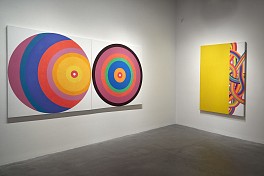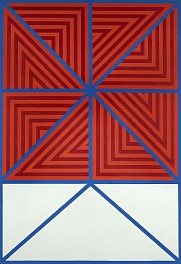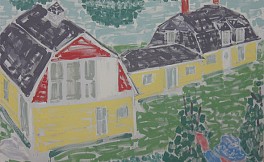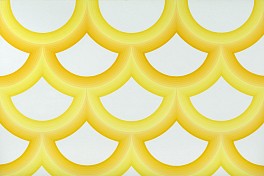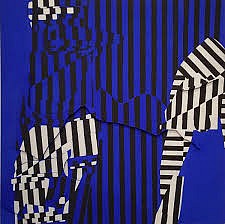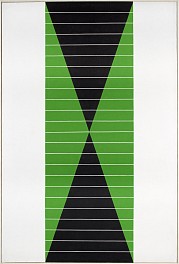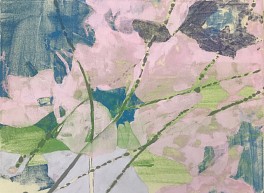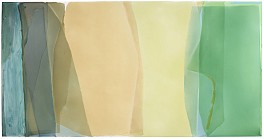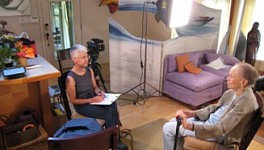Artist of the week | eazel highlights: Mary Dill Henry (1913 - 2009)
March 3, 2021 - Eazel
Mary Dill Henry (1913 - 2009)
Mary Dill Henry’s most notable works are in large oil paintings, alongside acrylics and prints; they are characterized by geometric abstraction. Henry built a signature style, synthesizing past and present art movements into bold and striking compositions.
A rare exhibition of paintings from 1965 to 1970 is on show at Berry Campbell Gallery, New York, titled Mary Dill Henry: Love Jazz (Feb 11 - Mar 13, 2021). Works from this period include oscillating shapes form kinetic patterns and Op Art illusions. This qulity can be seen in works such as Love Jazz (1965), same title as the exhibition, which represents two abstract hearts that seem to beat together in rhythmic unison with the variously striped patterns that both unite and divide them; that daringly juxtaposed colors arrest the eye with the immediacy of Pop Art.
The most significant influence on her practice occurred in the mid-1940s, while studying at the Institute of Design in Chicago with the Bauhaus teacher and visionary, László Moholy-Nagy (1895–1946). Studying under Moholy-Nagy exposed Henry to the illustrious history of the Bauhaus and its many manifestations. At the Institute, she pursued the full Bauhaus curriculum, receiving training in photography, architecture, and design.
After receiving an MA at the Institute of Design in Chicago, Henry was offered technical positions from several schools. However, the cultural atmosphere at the time normalized women to follow men’s career over their own; so Henry moved whenever her husband’s work required them to relocate. Although Henry was a serious artist and had regular exhibitions, she kept a low profile. In 1966, liberation from the marriage enabled Henry to focus on her art, although it meant she had to deal with financial struggles to a certain extent.
“It was as if, after 20 years of fulfilling conventional expectations as a wife, worker, and mother, she was released into a constant stream of creative production, capturing the exuberant hedonism of Northern California, while reined in by the consummate formal control she had assimilated as an American Constructivist in Chicago.”
- from Matthew Kangas’ review of Mary Dill Henry’s first solo exhibition at Arleigh Gallery, San Francisco (Artforum, 1969)
Through her artworks, Henry showed the utopian ideals associated with Constructivism, as well the principle behind de Stijl movement; that art and life are inseparable. Although influenced by these movements, Henry expressed more idiosyncratic and humorous constructive patterns in her works. She achieved a beauty of form that transcends the ordinary and gave joy and surprise to the eye. Henry’s consideration of contemplative spaces speaks to the viewer with energy and insight, while her sense of humor is also evident.
“Art sustains us when the chaos of the world with its wars and depressions engulf us. And the bright hope of humanity to know that even in the midst of such hopelessness, we can and do create art that can lift and inspire.”
- Mary Dill Henry
Mary Dill Henry: Love Jazz at Berry Campbell Gallery, New York (Feb 11 - Mar 13, 2021)
Starting from her first solo exhibition in 1967, Henry participated in hundreds of shows. Since 1980, seven retrospective exhibitions have been held in California, including several museum shows. Among many honors, she received a Flintridge Award for Visual Artists in 2001 and the Twining Humber Award for Lifetime Achievement, from the Artist Trust, in Seattle, in 2006.
Henry’s paintings belong to many public collections, including the Seattle Art Museum; the Frye Art Museum, Seattle; the Whatcom Museum, Bellingham, Washington; the Tacoma Art Museum; the University of Puget Sound, Tacoma; the Portland Art Museum, Oregon; the Sheldon Art Museum, University of Nebraska, Lincoln; and the Institute of Design, Chicago, as well as corporate art collections, including Microsoft, Safeco, Ampex, Varian Associates, and Hewlett-Packard.

